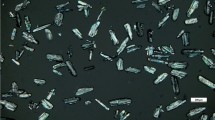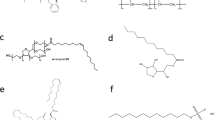Abstract
Purpose
The oral bioavailability of poorly water-soluble active pharmaceutical ingredients (APIs) can be improved by the preparation of amorphous solid dispersions (ASDs) where the API is dissolved in polymeric excipients. Desired properties of such ASDs like storage stability, dissolution behavior, and processability can be optimized by additional excipients. In this work, the influence of so-called low-molecular-weight excipients (LMWEs) on the phase behavior of ASDs was investigated.
Method
Binary ASDs of an amorphous API, naproxen (NAP) or acetaminophen (APAP), embedded in poly-(vinylpyrrolidone-co-vinyl acetate) (PVPVA64) were chosen as reference systems. Polyethylene glycol 1500 (PEG1500), D-α-tocopherol polyethylene glycol 1000 succinate (TPGS1000), propylene glycol monocaprylate type II (Capryol™ 90), and propylene glycol monolaurate type I (Lauroglycol™ FCC) were used as LMWEs. The API solubility in the excipients and the glass-transition temperature of the ASDs were modeled using the Perturbed-Chain Statistical Associating Fluid Theory (PC-SAFT) and the Kwei equation, respectively, and compared to corresponding experimental data.
Results
The API solubility curves in ternary systems with 90/10 wt%/wt% PVPVA64/LMWE ratios were very close to those in pure PVPVA64. However, the glass-transition temperatures of API/PVPVA64/LMWE ASDs were much lower than those of API/PVPVA64 ASDs. These effects were determined experimentally and agreed with the predictions using the PC-SAFT and Kwei models.
Conclusion
The impact of the LMWEs on the thermodynamic stability of the ASDs is quite small while the kinetic stability is significantly decreased even by small LMWE amounts. PC-SAFT and the Kwei equation are suitable tools for predicting the influence of LMWEs on the ASD phase behavior.







Similar content being viewed by others
Abbreviations
- APAP:
-
Acetaminophen
- API:
-
Active pharmaceutical ingredient
- ARD:
-
Average relative deviation
- ASD:
-
Amorphous solid dispersion
- DSC:
-
Differential scanning calorimetry
- HPMC:
-
Hydroxypropyl methylcellulose
- HPMCAS:
-
Hydroxypropyl methylcellulose acetate succinate
- LMWE:
-
Low-molecular-weight excipient
- NAP:
-
Naproxen
- PC-SAFT:
-
Perturbed-Chain Statistical Associating Fluid Theory
- PEG1500:
-
Polyethylene glycol 1500
- PVP:
-
Poly(vinylpyrrolidone)
- PVPVA64:
-
Poly(vinylpyrrolidone-co-vinyl acetate) (VA64)
- SLE:
-
Solid-liquid equilibrium
- TPGS1000:
-
D-α-tocopherol polyethylene glycol 1000 succinate
- \( \varDelta {\mathrm{c}}_{\mathrm{p},0,\mathrm{API}}^{\mathrm{SL}} \) :
-
Difference in the solid and liquid heat capacities of the pure API (J/(molK))
- \( \varDelta {\mathrm{h}}_{0,\mathrm{API}}^{\mathrm{SL}} \) :
-
Enthalpy of fusion of the pure API (J/mol)
- \( {\mathrm{T}}_{0,\mathrm{API}}^{\mathrm{SL}} \) :
-
Melting temperature of the pure API (K)
- a :
-
Helmholtz energy (J)
- K :
-
Gordon-Taylor binary parameter
- kB :
-
Boltzmann constant
- kij :
-
PC-SAFT binary interaction parameter
- M :
-
Molar mass (g/mol)
- mseg :
-
Segment number
- Nassoc :
-
Number of association sites
- qij :
-
Kwei binary interaction parameter
- R :
-
Universal gas constant (8.1345 J/(molK))
- T :
-
Temperature (K)
- Tg :
-
Glass-transition temperature (K)
- u/kB :
-
Dispersion-energy parameter (K)
- w :
-
Content (wt%)
- x :
-
Mole fraction
- γ :
-
Activity coefficient
- εAiBi/kB :
-
Association-energy parameter (K)
- κAiBi :
-
Association-volume parameter
- ρ :
-
Density (g/cm3)
- σ :
-
Segment diameter (Å)
- 0 :
-
Pure component
- API :
-
Active pharmaceutical ingredient
- calcd :
-
Calculated
- exptl :
-
Experimental
- hc :
-
Hard chain
- L :
-
Liquid phase
- LMWE :
-
Low-molecular-weight excipient
- Ai, Bi :
-
Association sites A and B of molecule i
- assoc.:
-
Association
- disp:
-
Dispersion
- i, j:
-
Component indices
- res:
-
Residual
- seg:
-
Segment
- SL:
-
Solid-liquid
REFERENCES
Serajuddin AT. Solid dispersion of poorly water-soluble drugs: early promises, subsequent problems, and recent breakthroughs. J Pharm Sci. 1999;88(10):1058–66.
Vasconcelos T, Sarmento B, Costa P. Solid dispersions as strategy to improve oral bioavailability of poor water soluble drugs. Drug Discov Today. 2007;12(23–24):1068–75.
Chiou WL, Riegelman S. Pharmaceutical applications of solid dispersion systems. J Pharm Sci. 1971;60(9):1281–302.
Leuner C, Dressman J. Improving drug solubility for oral delivery using solid dispersions. Eur J Pharm Biopharm. 2000;50(1):47–60.
Murdande SB, Pikal MJ, Shanker RM, Bogner RH. Solubility advantage of amorphous pharmaceuticals: I. A thermodynamic analysis. J Pharm Sci. 2010;99(3):1254–64.
Paus R, Ji Y, Vahle L, Sadowski G. Predicting the solubility advantage of amorphous pharmaceuticals: a novel thermodynamic approach. Mol Pharm. 2015;12(8):2823–33.
Hancock BC, Parks M. What is the true solubility advantage for amorphous pharmaceuticals? Pharm Res. 2000;17(4):397–404.
Babu NJ, Nangia A. Solubility advantage of amorphous drugs and pharmaceutical cocrystals. Cryst Growth Des. 2011;11(7):2662–79.
Baghel S, Cathcart H, O'Reilly NJ. Polymeric amorphous solid dispersions: a review of amorphization, crystallization, stabilization, solid-state characterization, and aqueous solubilization of biopharmaceutical classification system class II drugs. J Pharm Sci. 2016;105(9):2527–44.
Kyeremateng SO, Pudlas M, Woehrle GH. A fast and reliable empirical approach for estimating solubility of crystalline drugs in polymers for hot melt extrusion formulations. J Pharm Sci. 2014;103(9):2847–58.
Hancock BC, Shamblin SL, Zografi G. Molecular mobility of amorphous pharmaceutical solids below their glass transition temperatures. Pharm Res. 1995;12(6):799–806.
Huang Y, Dai W-G. Fundamental aspects of solid dispersion technology for poorly soluble drugs. Acta Pharm Sin B. 2014;4(1):18–25.
Janssens S, Nagels S, Armas HND, D’Autry W, van Schepdael A, van den Mooter G. Formulation and characterization of ternary solid dispersions made up of itraconazole and two excipients, TPGS 1000 and PVPVA 64, that were selected based on a supersaturation screening study. Eur J Pharm Biopharm. 2008;69(1):158–66.
Prudic A, Ji Y, Sadowski G. Thermodynamic phase behavior of API/polymer solid dispersions. Mol Pharm. 2014;11(7):2294–304.
Tao J, Sun Y, Zhang GGZ, Yu L. Solubility of small-molecule crystals in polymers: D-mannitol in PVP, indomethacin in PVP/VA, and nifedipine in PVP/VA. Pharm Res. 2009;26(4):855–64.
Qian F, Huang J, Hussain MA. Drug-polymer solubility and miscibility: stability consideration and practical challenges in amorphous solid dispersion development. J Pharm Sci. 2010;99(7):2941–7.
Lehmkemper K, Kyeremateng SO, Heinzerling O, Degenhardt M, Sadowski G. Long-term physical stability of PVP- and PVPVA-amorphous solid dispersions. Mol Pharm. 2017;14(1):157–71.
Theil F, Anantharaman S, Kyeremateng SO, van Lishaut H, Dreis-Kuhne SH, Rosenberg J, et al. Frozen in time: kinetically stabilized amorphous solid dispersions of nifedipine stable after a quarter century of storage. Mol Pharm. 2017;14(1):183–92.
Prudic A, Ji Y, Luebbert C, Sadowski G. Influence of humidity on the phase behavior of API/polymer formulations. Eur J Pharm Biopharm. 2015;94:352–62.
Mura P, Faucci MT, Manderioli A, Bramanti G, Parrini P. Thermal behavior and dissolution properties of naproxen from binary and ternary solid dispersions. Drug Dev Ind Pharm. 1999;25(3):257–64.
Wang X, Michoel A, van den Mooter G. Solid state characteristics of ternary solid dispersions composed of PVP VA64, Myrj 52 and itraconazole. Int J Pharm. 2005;303(1–2):54–61.
Savjani KT, Gajjar AK, Savjani JK. Drug solubility: importance and enhancement techniques. ISRN Pharm. 2012;2012:195727.
Williams HD, Trevaskis NL, Charman SA, Shanker RM, Charman WN, Pouton CW, et al. Strategies to address low drug solubility in discovery and development. Pharmacol Rev. 2012;65(1):315–499.
Park S-H, Choi H-K. The effects of surfactants on the dissolution profiles of poorly water-soluble acidic drugs. Int J Pharm. 2006;321(1–2):35–41.
Serajuddin AT, Mufson D, Bernstein DF, Sheen P-C, Augustine MA. Effect of vehicle amphiphilicity on the dissolution and bioavailability of a poorly water-soluble drug from solid dispersions. J Pharm Sci. 1988;77(5):414–7.
Repka MA, McGinity JW. Influence of vitamin E TPGS on the properties of hydrophilic films produced by hot-melt extrusion. Int J Pharm. 2000;202(1–2):63–70.
Ghebremeskel AN, Vemavarapu C, Lodaya M. Use of surfactants as plasticizers in preparing solid dispersions of poorly soluble API: selection of polymer–surfactant combinations using solubility parameters and testing the processability. Int J Pharm. 2007;328(2):119–29.
Kwei TK. The effect of hydrogen bonding on the glass transition temperatures of polymer mixtures. Acta Pharm Sin B. 1984;22(6):307–13.
Gross J, Sadowski G. Perturbed-shain SAFT. An equation of state based on a perturbation theory for chain molecules. Ind Eng Chem Res. 2001;40(4):1244–60.
Gordon M, Taylor JS. Ideal copolymers and the second-order transitions of synthetic rubbers. i. non-crystalline copolymers. J Appl Chem. 1952;2(9):493–500.
Kalogeras IM. A novel approach for analyzing glass-transition temperature vs. composition patterns: application to pharmaceutical compound+polymer systems. Eur J Pharm Sci. 2011;42(5):470–83.
Prudic A, Kleetz T, Korf M, Ji Y, Sadowski G. Influence of copolymer composition on the phase behavior of solid dispersions. Mol Pharm. 2014;11(11):4189–98.
Prausnitz JM, Lichtenthaler RN, Azevedo EGD. Molecular thermodynamics of fluid-phase equilibria. 3rd ed. Upper Saddle River, N.J: Prentice-Hall; 1999.
Paus R, Ji Y, Braak F, Sadowski G. Dissolution of crystalline pharmaceuticals: Experimental investigation and thermodynamic modeling. Ind Eng Chem Res. 2015;54(2):731–42.
Granberg RA, Rasmuson ÅC. Solubility of paracetamol in pure solvents. J Chem Eng Data. 1999;44(6):1391–5.
Gross J, Sadowski G. Modeling polymer systems using the perturbed-chain statistical associating fluid theory equation of state. Ind Eng Chem Res. 2002;41(5):1084–93.
Ruether F, Sadowski G. Modeling the solubility of pharmaceuticals in pure solvents and solvent mixtures for drug process design. J Pharm Sci. 2009;98(11):4205–15.
Eastman Chemical Company. Eastman vitamin E TPGS NF - applications and properties. October 2005.
Stoychev I, Galy J, Fournel B, Lacroix-Desmazes P, Kleiner M, Sadowski G. Modeling the phase behavior of PEO−PPO−PEO surfactants in carbon dioxide using the PC-SAFT equation of state: application to dry decontamination of solid substrates †. J Chem Eng Data. 2009;54(5):1551–9.
Hancock BC, Zografi G. Characteristics and significance of the amorphous state in pharmaceutical systems. J Pharm Sci. 1997;86(1):1–12.
Six K, Verreck G, Peeters J, Brewster M, van den Mooter G. Increased physical stability and improved dissolution properties of itraconazole, a class II drug, by solid dispersions that combine fast- and slow-dissolving polymers. J Pharm Sci. 2004;93(1):124–31.
Simha R, Boyer RF. On a general relation involving the glass temperature and coefficients of expansion of polymers. J Chem Phys. 1962;37(5):1003–7.
Paudel A, van Humbeeck J, van den Mooter G. Theoretical and experimental investigation on the solid solubility and miscibility of naproxen in poly(vinylpyrrolidone). Mol Pharm. 2010;7(4):1133–48.
Nair R, Nyamweya N, Gönen S, Martinez-Miranda LJ, Hoag SW. Influence of various drugs on the glass transition temperature of poly(vinylpyrrolidone): a thermodynamic and spectroscopic investigation. Int J Pharm. 2001;225(1–2):83–96.
Polyethylene glycol [MAK Value Documentation, 1998], in: The MAK-Collection for OccupationalHealth and Safety, Wiley-VCH Verlag GmbH & Co. KGaA: Weinheim; 2002. pp. 248–70.
Godovski Y, Slonimskii GL, Garbar NM. Effect of molecular weight on the crystallization, melting, glass-transition and morphology in the ethylene glycol-polyethylene glycol series. Polym Sci (USSR). 1973;15(4):914–31.
Hancock BC, Zografi G. The relationship between the glass transition temperature and the water content of amorphous pharmaceutical solids. Pharm Res. 1994;11(4):471–7.
Mohan R, Lorenz H, Myerson AS. Solubility measurement using differential scanning calorimetry. Ind Eng Chem Res. 2002;41(19):4854–62.
Zhang Z, Tan S, Feng S-S. Vitamin E TPGS as a molecular biomaterial for drug delivery. Biomaterials. 2012;33(19):4889–906.
ACKNOWLEDGMENTS AND DISCLOSURES
This study was funded by AbbVie. AbbVie participated in the study design, research, data collection, analysis and interpretation of data, as well as writing, reviewing, and approving the publication. S.K., M.D., and K.L. are AbbVie employees and may own AbbVie stock/options. G.S. is an employee at the Department for Biochemical and Chemical Engineering of the TU Dortmund University and has no conflict of interest to report.
Author information
Authors and Affiliations
Corresponding authors
Electronic supplementary material
ESM 1
(DOCX 184 kb)
Rights and permissions
About this article
Cite this article
Lehmkemper, K., Kyeremateng, S.O., Degenhardt, M. et al. Influence of Low-Molecular-Weight Excipients on the Phase Behavior of PVPVA64 Amorphous Solid Dispersions. Pharm Res 35, 25 (2018). https://doi.org/10.1007/s11095-017-2316-y
Received:
Accepted:
Published:
DOI: https://doi.org/10.1007/s11095-017-2316-y




